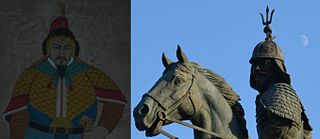Career
After Sŏ Hŭi passed gwageo, the state examination, with a high grade, in March 960, the 11th year of King Gwangjong's reign, he served for the government as the Gwangpyeongwon eorang (廣評員外郎) and Naeui sirang (內議侍郎) posts. In 983, Sŏ became Byeonggwan eosa (兵官御事), the official in charge of military affairs. Soon after that, he was appointed to important positions like Naesasirang pyeongsangsa (內史侍郎平章事), the second rank of the Chancellory, and finally he was raised to the highest position of Taebo Naesaryeong, the head of Supreme Council. [3] In addition to his role in domestic politics, Sŏ engaged in diplomacy by going to China in 972 and playing an important role in re-establishing the diplomatic relationship between Goryeo and the Chinese Song dynasty, which had been broken off over a decade earlier.[ citation needed ]
Negotiations with Liao

However, he is most remembered in his diplomatic career for his direct negotiations with General Xiao Sunning of the Liao dynasty, which prevented a fullscale invasion by a host of Khitan troops: [3]
According to the story, after Xiao captured Pongsan county in 993 and forced Goryeo's forces to retreat behind the Taedong River, he wrote to demand Goryeo's surrender: "[O]ur great country is about to unify land on all four directions" and to justify the expedition by charging: "your country does not take care of the people's needs, we solemnly execute heaven's punishment on its behalf". King Seongjong of Goryeo initially accepted Liao's demands, planning on the advice of his negotiators to give up the land north of Pyongyang to Xiao and drawing the Liao-Goryeo border in a straight line between Hwangju and P'aryŏng. [5]
Sŏ Hŭi, however, was convinced that the Liao were acting from a position of "fear of us" and begged the king to "return to the capital and let us, your officers, wage one more battle". Sŏ rhetorically referred to the land that King Gwangjong had conquered from the Jurchens and which the Khitans (Liao) now held as "former Koguryŏ territory". After Xiao's forces were repulsed from further advances at the Battle of Anyung Fortress, Sŏ went to the Liao encampment to negotiate a settlement. Part of their conversation is excerpted: [5]
Xiao: Your country arose in Silla territory. Koguryŏ territory is in our possession. But you have encroached on it. Your country is connected to us by land, and yet you cross the sea to serve China. Because of this, our great country came to attack you. If you relinquish land to us and establish a tributary relationship, everything will be all right.
Sŏ: That is not so. Our country is in fact former Koguryŏ, and that is why it is named Koryŏ and has a capital at P'yŏngyang. If you want to discuss territorial boundaries, the Eastern Capital of your country is within our borders.... Moreover, the land on both sides of the Yalu River is also within our borders, but the Jurchens have now stolen it.... If you tell us to drive out the Jurchens, recover our former territory, construct fortresses, and open the roads, then how could we dare not to have [tributary] relations?"
Sŏ reported to his king that he forged an agreement with Xiao to jointly "exterminate the Jurchens" and to seize their land so that Goryeo and Liao would have a closer land border and commensurate tributary relations. He lamented that the Jurchens would only allow Goryeo the land south of the Yalu River, but envisioned a future in which this situation of confinement would change. [5]
Later, Sŏ Hŭi fortified the newly expanded territory, which gave Goryeo a decisive victory in the second and third conflicts after his death.











